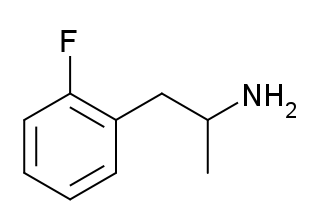
A heterocyclic compound or ring structure is a cyclic compound that has atoms of at least two different elements as members of its ring(s). Heterocyclic chemistry is the branch of organic chemistry dealing with the synthesis, properties, and applications of these heterocycles.

Imidazole (ImH) is an organic compound with the formula C3N2H4. It is a white or colourless solid that is soluble in water, producing a mildly alkaline solution. In chemistry, it is an aromatic heterocycle, classified as a diazole, and has non-adjacent nitrogen atoms in meta-substitution.

An oxazolidine is a five-membered ring compound consisting of three carbon atoms, a nitrogen atom and an oxygen atom. The O atom and NH group are the 1 and 3 positions, respectively. In oxazolidine derivatives, there is always a carbon atom between the O and N atoms. All of the carbon atoms in oxazolidines are reduced. Some of their derivatives, the oxazolidinediones, are used as anticonvulsants.
Pyrazine is a heterocyclic aromatic organic compound with the chemical formula C4H4N2. It is a symmetrical molecule with point group D2h. Pyrazine is less basic than pyridine, pyridazine and pyrimidine. It is a "deliquescent crystal or wax-like solid with a pungent, sweet, corn-like, nutty odour".

Benzofuran is the heterocyclic compound consisting of fused benzene and furan rings. This colourless liquid is a component of coal tar. Benzofuran is the "parent" of many related compounds with more complex structures. For example, psoralen is a benzofuran derivative that occurs in several plants.

Indazole, also called isoindazole, is a heterocyclic aromatic organic compound. This bicyclic compound consists of the fusion of benzene and pyrazole.

Oxazole is the parent compound for a vast class of heterocyclic aromatic organic compounds. These are azoles with an oxygen and a nitrogen separated by one carbon. Oxazoles are aromatic compounds but less so than the thiazoles. Oxazole is a weak base; its conjugate acid has a pKa of 0.8, compared to 7 for imidazole.
Isoxazole is an electron-rich azole with an oxygen atom next to the nitrogen. It is also the class of compounds containing this ring. Isoxazolyl is the univalent radical derived from isoxazole.
In chemistry, a derivative is a compound that is derived from a similar compound by a chemical reaction.

Benzoxazole is an aromatic organic compound with a molecular formula C7H5NO, a benzene-fused oxazole ring structure, and an odor similar to pyridine. Although benzoxazole itself is of little practical value, many derivatives of benzoxazoles are commercially important.
A triazole is a heterocyclic compound featuring a five-membered ring of two carbon atoms and three nitrogen atoms with molecular formula C2H3N3. Triazoles exhibit substantial isomerism, depending on the positioning of the nitrogen atoms within the ring.
A structural analog, also known as a chemical analog or simply an analog, is a compound having a structure similar to that of another compound, but differing from it in respect to a certain component.

Thioescaline (TE) is a pair of lesser-known psychedelic drugs with the chemical formula C12H19NO2S. They structural analogs of escaline in which an oxygen atom has been replaced with a sulfur atom. They were first synthesized by Alexander Shulgin and reported in his book PiHKAL. Very little is known about their dangers or toxicity.
Thiomescaline (TM) is a pair of lesser-known psychedelic drugs with the molecular formula C11H17NO2S. 3-TM and 4-TM are analogs of mescaline in which an oxygen atom has been replaced with a sulfur atom. They were first synthesized by Alexander Shulgin and described in his book PiHKAL. Very little data exists on the pharmacological properties, metabolism, and toxicity of thiomescaline.

Substituted phenethylamines are a chemical class of organic compounds that are based upon the phenethylamine structure; the class is composed of all the derivative compounds of phenethylamine which can be formed by replacing, or substituting, one or more hydrogen atoms in the phenethylamine core structure with substituents.

2-Fluoroamphetamine (2-FA) is a stimulant drug from the amphetamine family which has been sold as a designer drug. 2-Fluoroamphetamine differs from 3- and 4-fluoroamphetamine in the position of the fluorine atom on the aromatic ring, making them positional isomers of one another. The replacement of a hydrogen atom with a fluorine atom in certain compounds to facilitate passage through the blood–brain barrier, as is desirable in central nervous system pharmaceutical agents, is a common practice due to the corresponding increase in lipophilicity granted by this substitution.

HU-243 (AM-4056) is a synthetic cannabinoid drug that is a single enantiomer of the hydrogenated derivative of the commonly used reference agonist HU-210. It is a methylene homologue of canbisol. It is a potent agonist at both the CB1 and CB2 receptors, with a binding affinity of 0.041 nM at the CB1 receptor, making it marginally more potent than HU-210, which had an affinity of 0.061 nM in the same assay.
Argument from analogy or false analogy is a special type of inductive argument, whereby perceived similarities are used as a basis to infer some further similarity that has yet to be observed. Analogical reasoning is one of the most common methods by which human beings attempt to understand the world and make decisions. When a person has a bad experience with a product and decides not to buy anything further from the producer, this is often a case of analogical reasoning. It is also implicit in much of science; for instance, experiments on laboratory rats typically proceed on the basis that some physiological similarities between rats and humans entails some further similarity.

A telluroketone is an analog of a ketone in which the oxygen atom has been replaced by a tellurium atom. This change makes the functional group less stable, requiring greater steric and electronic stabilization.












